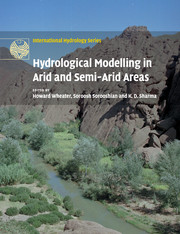Book contents
- Frontmatter
- Contents
- List of contributors
- Preface
- Acknowledgements
- 1 Modelling hydrological processes in arid and semi-arid areas: an introduction
- 2 Global precipitation estimation from satellite imagery using artificial neural networks
- 3 Modelling semi-arid and arid hydrology and water resources: The southern Africa experience
- 4 Use of the IHACRES rainfall-runoff model in arid and semi-arid regions
- 5 KINEROS2 and the AGWA modelling Framework
- 6 Ephemeral flow and sediment delivery modelling in the Indian arid zone
- 7 The modular modelling system (MMS): a toolbox for water and environmental resources management
- 8 Calibration, uncertainty, and regional analysis of conceptual rainfall-runoff models
- 9 Real-time flow forecasting
- 10 Real-time flood forecasting: Indian experience
- 11 Groundwater modelling in hard-rock terrain in semi-arid areas: experience from India
- Appendix Access to software and data products
- Index
- Plate section
- References
7 - The modular modelling system (MMS): a toolbox for water and environmental resources management
Published online by Cambridge University Press: 15 December 2009
- Frontmatter
- Contents
- List of contributors
- Preface
- Acknowledgements
- 1 Modelling hydrological processes in arid and semi-arid areas: an introduction
- 2 Global precipitation estimation from satellite imagery using artificial neural networks
- 3 Modelling semi-arid and arid hydrology and water resources: The southern Africa experience
- 4 Use of the IHACRES rainfall-runoff model in arid and semi-arid regions
- 5 KINEROS2 and the AGWA modelling Framework
- 6 Ephemeral flow and sediment delivery modelling in the Indian arid zone
- 7 The modular modelling system (MMS): a toolbox for water and environmental resources management
- 8 Calibration, uncertainty, and regional analysis of conceptual rainfall-runoff models
- 9 Real-time flow forecasting
- 10 Real-time flood forecasting: Indian experience
- 11 Groundwater modelling in hard-rock terrain in semi-arid areas: experience from India
- Appendix Access to software and data products
- Index
- Plate section
- References
Summary
INTRODUCTION
Increasing demands for limited fresh-water supplies, and increasing complexity of environmental resource-management issues, present resource managers with the difficult task of achieving an equitable balance of resource allocation among a diverse group of users. Achieving such a balance is most difficult in arid and semi-arid regions. Hydrological and ecosystem models are often the tools being employed to address these resource-allocation issues.
The inter-disciplinary nature of water- and environmental-resource problems requires the use of modelling approaches that can incorporate knowledge from a broad range of scientific disciplines. Selection and application of appropriate models and tools is a function of a number of evaluation criteria, including problem objectives, data constraints, and spatial and temporal scales of application. The US Geological Survey (USGS) Modular Modelling System (MMS) (Leavesley et al., 1996b) is an integrated system of computer software that provides a research and operational framework to support the development and integration of a wide variety of hydrologic and ecosystem models, and their application to water- and environmental-resources management.
MMS supports the integration of models and tools at a variety of levels of modular design. These include individual process models, tightly coupled models, loosely coupled models, and fully integrated decision-support systems. A geographic information system (GIS) interface, the GIS Weasel, has been integrated with MMS to enable spatial delineation and characterization of basin and ecosystem features, and to provide objective parameter-estimation methods for selected models using available digital data coverages.
- Type
- Chapter
- Information
- Hydrological Modelling in Arid and Semi-Arid Areas , pp. 87 - 98Publisher: Cambridge University PressPrint publication year: 2007
References
- 1
- Cited by



